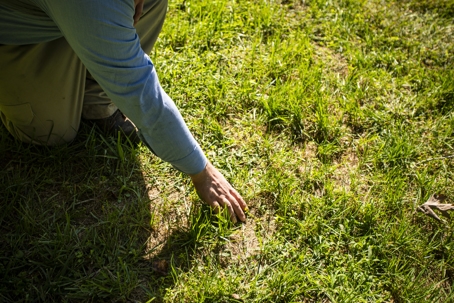How to Identify and Treat Common Lawn Diseases in Maryland
Weeds are mostly easy to spot in your lawn. You can usually see soggy spots where water collects. You can beam with pride at a nicely cut and edged corner of grass.
But grass diseases are another story all together.
The right conditions can bring them about without warning. And most of the diseases out there resemble some sort of patchy or irregularly shaped brown spots in your lawn. For all you know, those marks could be from drought or where your dog likes to mark his territory.
Yep, lawn diseases are tough to recognize. Luckily, there are a few common ones that pop up in Maryland. Let’s review the worst offenders to help you sharpen your identification skills, as well as suggest ways you can keep these eye sores to a minimum in your yard.
5 Common Lawn Diseases in Maryland
What you’re after for a great lawn is expanses of thick, green grass stands. A sea of green that smells like summer and outdoor freshness.
Grass diseases tend to show up in your lawn in a very aesthetically unpleasing way. They bring spots and patches.
Some common lawn diseases in Maryland attack certain grass types, and many times certain conditions make these diseases worse. But there are things you can do, based on the specific disease type, that can protect your lawn and help get it back to thick, green, and blemish-free.
Here are 5 Maryland lawn diseases you need to watch out for, their causes, and how to fight their spread.
1. Red Thread
Cool, moist weather drives red thread on a lawn that lacks proper fertilization and nutrients. Here, experts define this as temperatures between 59 and 77 degrees Fahrenheit combined with excess rain. Think springtime.
It’s actually caused by a fungus and comes at the lawn in two stages. First is the stage that gives this disease in your lawn it’s name: thin, red, needle-like strands extending from grass blades. The lawn fungus grows from these strands. This is also how the disease is spread via wind or even through contaminated equipment. Then comes the visible, pink, cotton-like spots that start as yellow or lighter green patches. 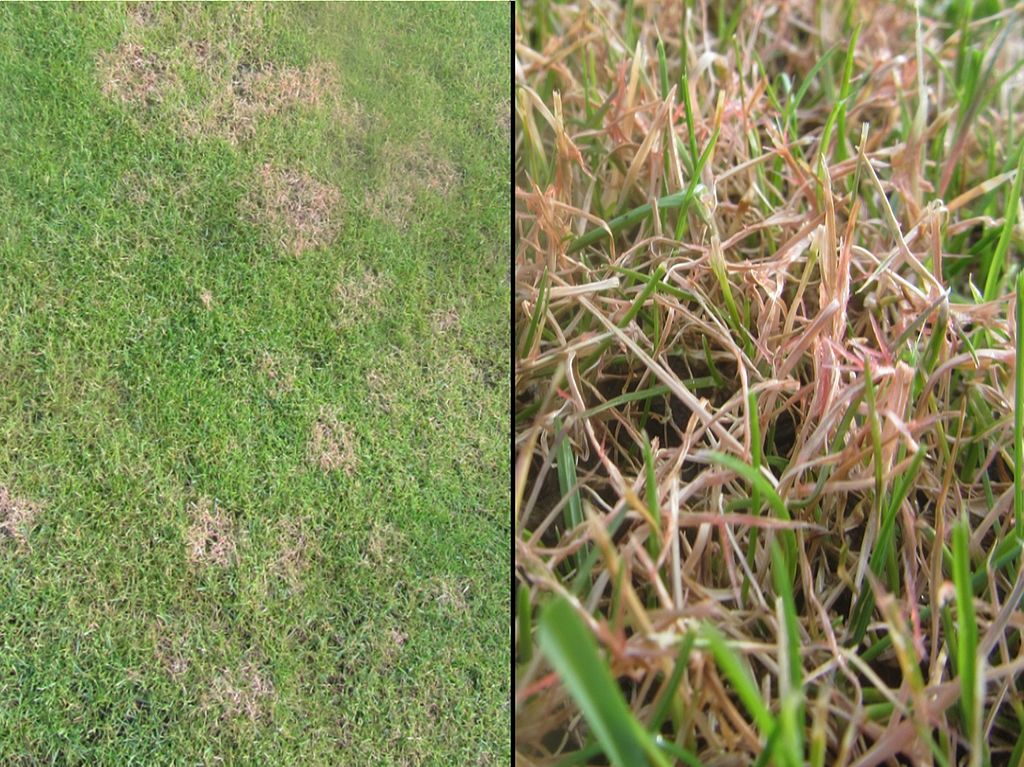 To manage this disease, start by managing the conditions that cause it. Since red thread likes grass with poor nutrition, a nitrogen-based, balanced fertilization program will boost lawn health and reduce disease severity. This alone can usually do the trick to eliminate red thread.
To manage this disease, start by managing the conditions that cause it. Since red thread likes grass with poor nutrition, a nitrogen-based, balanced fertilization program will boost lawn health and reduce disease severity. This alone can usually do the trick to eliminate red thread.
2. Rust
Rust, similar to red thread, is a largely cosmetic disease in your lawn.
It starts with yellow, orange spores or fruiting bodies that damage grass blades. In fact, if your lawn has rust and you walk through it, you might notice bits of these yellow-orange spores come off on your shoes. You can see them on the grass blades if you look closely. This is how the disease spreads.
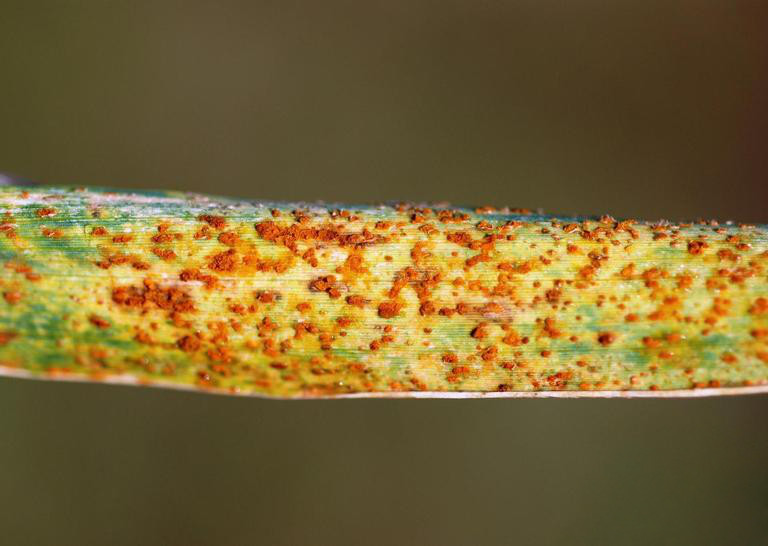 Rust likes more moderate temperatures -- anywhere from 50 to 60 degrees Fahrenheit, as well as long evenings of dew or moisture -- more than 10 hours.
Rust likes more moderate temperatures -- anywhere from 50 to 60 degrees Fahrenheit, as well as long evenings of dew or moisture -- more than 10 hours.
A healthy lawn is your best defense against rust, particularly a balanced fertilization program.
3. Powdery Mildew
Powdery mildew attacks lawns through their grass blades. Like some other lawn diseases, it’s also caused by a fungus with a weird name -- blumeria graminis.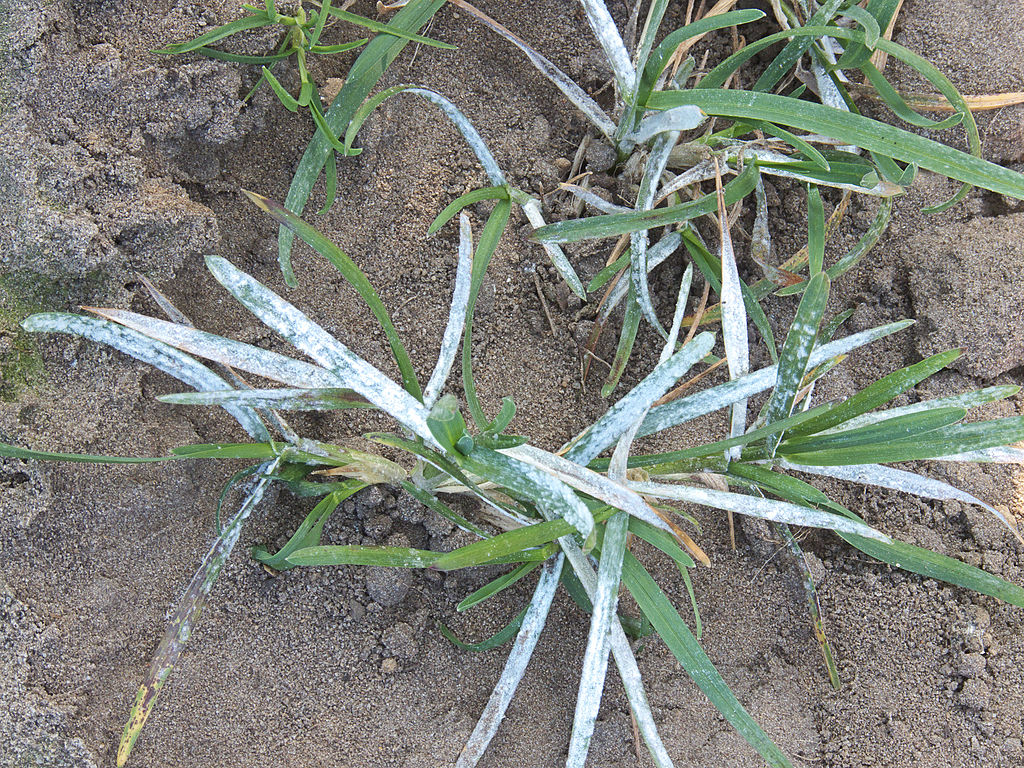 The first symptoms of this grass disease are light spots in the lawn. As the disease progresses, you’ll begin to notice white patches that look like they’ve been sprinkled with baby powder.
The first symptoms of this grass disease are light spots in the lawn. As the disease progresses, you’ll begin to notice white patches that look like they’ve been sprinkled with baby powder.
The disease can be present but not cause symptoms until the conditions are right. Powdery mildew likes shady locations with poor air circulation. If you water your lawn at night without giving it a chance to dry properly, you’re encouraging this disease to spread.
Opening air flow and reducing shade by pruning nearby trees can help, but this isn’t always possible based on your location.
To prevent this disease in your lawn, water the lawn early in the day so it has time to dry out and water shaded areas infrequently but deeply.
4. Dollar Spot
Dollar spot in one of those grass diseases that impacts a variety of species in Central and Southern Maryland.
This fungus appears as small straw-colored circles on Kentucky bluegrass more than tall fescue. Spots start out the size of silver dollars, hence the name dollar spot. Think 2- to 6-inch spots. They can be very unsightly, especially as they multiply.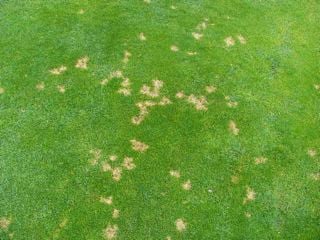 Dollar spot usually comes along in late spring and can last through fall, causing the most damage in June and July. It loves under-fertilized turf, as well as grass impacted by drought and compaction.
Dollar spot usually comes along in late spring and can last through fall, causing the most damage in June and July. It loves under-fertilized turf, as well as grass impacted by drought and compaction.
If you take care of your lawn with adequate fertilization and annual aeration and overseeding treatments, you can keep dollar spot from taking over your lawn.
5. Brown Patch
Along with humidity and summer temperatures comes a grass disease called brown patch.
Just like its name implies, brown patch appears in circular patches that are brownish-yellow in color on some cool-season and warm-season grasses. This lawn disease likes heat and humidity, particularly when nighttime temperatures remain consistently above 68 degrees Fahrenheit and daytime temperatures are at 85 degrees Fahrenheit or above. 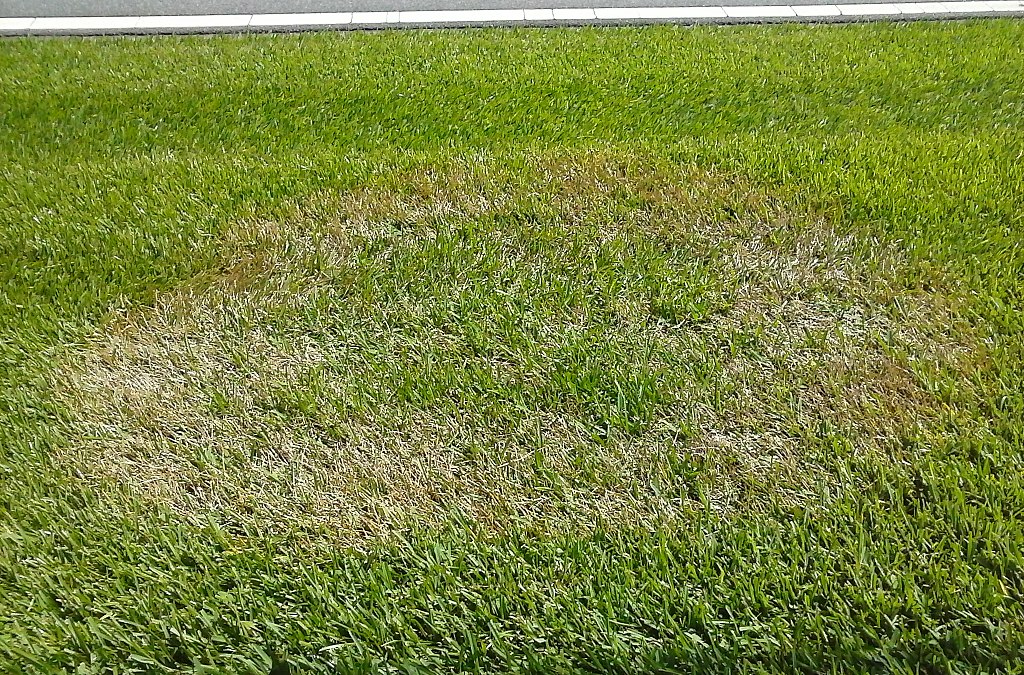 To battle this lawn enemy, remember to properly fertilize your lawn. Once rainfall resumes after dry summers, this disease usually begins to disappear as well. Overseeding your lawn in the fall can help thicken up any thin areas, helping to further protect it from problems down the road.
To battle this lawn enemy, remember to properly fertilize your lawn. Once rainfall resumes after dry summers, this disease usually begins to disappear as well. Overseeding your lawn in the fall can help thicken up any thin areas, helping to further protect it from problems down the road.
Get Rid of Grass Disease in Your Maryland Lawn
Now that you know more about some of the most common lawn diseases in Maryland, you might be able to identify any strange spots you’re seeing show up in your yard, as well as make a list of what you need to do to better manage them.
In addition to boosting overall lawn health with fertilization, aeration, proper watering, and mowing, you might still find you have some spots that are more disease-prone than others. This is totally normal. In fact, if you have places that tend to deliver the right disease conditions frequently, your disease pressure will be higher. For instance, places that have shade most of the morning and day and only a bit of sun in the evening don’t get a chance to dry out or cool, so they go into the evening warmer than other locations. This is a recipe for diseases to spread.
Also, since Central and Southern Maryland summers can get fairly warm and humid, roughly 80 percent of lawns here experience some form of lawn disease.
If you notice patches, do some work to improve your lawn, and are still suffering from spotty, blemished grass, you might also want to consider turf disease control. As an add-on to your current lawn care program, fungicide treatments are usually done best in a minimum of two, but preferably three to four, treatments throughout the growing season. Applying this product preventively is the best way to fight diseases in lawns.
Still confused about whether or not you have a disease problem in your lawn? Tired of seeing spots? Don’t let fungal infections spoil your summer. Give Natural Green a call. We can tell you what’s really going on in your lawn and offer some suggestions to get that green, thick grass back.
Are lawn diseases keeping you from having a yard you can be proud of? We’d love to learn more. Get started today with a free quote. Together, we’ll prepare a customized plan for your Central or Southern Maryland lawn that leads you to the best choice for you and your lawn.
Image Source: Red Thread, Rust, Powdery Mildew, Dollar Spot, Brown Patch
Weeds are mostly easy to spot in your lawn. You can usually see soggy spots where water collects. You can beam with pride at a nicely cut and edged corner of grass.
But grass diseases are another story all together.
The right conditions can bring them about without warning. And most of the diseases out there resemble some sort of patchy or irregularly shaped brown spots in your lawn. For all you know, those marks could be from drought or where your dog likes to mark his territory.
Yep, lawn diseases are tough to recognize. Luckily, there are a few common ones that pop up in Maryland. Let’s review the worst offenders to help you sharpen your identification skills, as well as suggest ways you can keep these eye sores to a minimum in your yard.
5 Common Lawn Diseases in Maryland
What you’re after for a great lawn is expanses of thick, green grass stands. A sea of green that smells like summer and outdoor freshness.
Grass diseases tend to show up in your lawn in a very aesthetically unpleasing way. They bring spots and patches.
Some common lawn diseases in Maryland attack certain grass types, and many times certain conditions make these diseases worse. But there are things you can do, based on the specific disease type, that can protect your lawn and help get it back to thick, green, and blemish-free.
Here are 5 Maryland lawn diseases you need to watch out for, their causes, and how to fight their spread.
1. Red Thread
Cool, moist weather drives red thread on a lawn that lacks proper fertilization and nutrients. Here, experts define this as temperatures between 59 and 77 degrees Fahrenheit combined with excess rain. Think springtime.
It’s actually caused by a fungus and comes at the lawn in two stages. First is the stage that gives this disease in your lawn it’s name: thin, red, needle-like strands extending from grass blades. The lawn fungus grows from these strands. This is also how the disease is spread via wind or even through contaminated equipment. Then comes the visible, pink, cotton-like spots that start as yellow or lighter green patches.  To manage this disease, start by managing the conditions that cause it. Since red thread likes grass with poor nutrition, a nitrogen-based, balanced fertilization program will boost lawn health and reduce disease severity. This alone can usually do the trick to eliminate red thread.
To manage this disease, start by managing the conditions that cause it. Since red thread likes grass with poor nutrition, a nitrogen-based, balanced fertilization program will boost lawn health and reduce disease severity. This alone can usually do the trick to eliminate red thread.
2. Rust
Rust, similar to red thread, is a largely cosmetic disease in your lawn.
It starts with yellow, orange spores or fruiting bodies that damage grass blades. In fact, if your lawn has rust and you walk through it, you might notice bits of these yellow-orange spores come off on your shoes. You can see them on the grass blades if you look closely. This is how the disease spreads.
 Rust likes more moderate temperatures -- anywhere from 50 to 60 degrees Fahrenheit, as well as long evenings of dew or moisture -- more than 10 hours.
Rust likes more moderate temperatures -- anywhere from 50 to 60 degrees Fahrenheit, as well as long evenings of dew or moisture -- more than 10 hours.
A healthy lawn is your best defense against rust, particularly a balanced fertilization program.
3. Powdery Mildew
Powdery mildew attacks lawns through their grass blades. Like some other lawn diseases, it’s also caused by a fungus with a weird name -- blumeria graminis. The first symptoms of this grass disease are light spots in the lawn. As the disease progresses, you’ll begin to notice white patches that look like they’ve been sprinkled with baby powder.
The first symptoms of this grass disease are light spots in the lawn. As the disease progresses, you’ll begin to notice white patches that look like they’ve been sprinkled with baby powder.
The disease can be present but not cause symptoms until the conditions are right. Powdery mildew likes shady locations with poor air circulation. If you water your lawn at night without giving it a chance to dry properly, you’re encouraging this disease to spread.
Opening air flow and reducing shade by pruning nearby trees can help, but this isn’t always possible based on your location.
To prevent this disease in your lawn, water the lawn early in the day so it has time to dry out and water shaded areas infrequently but deeply.
4. Dollar Spot
Dollar spot in one of those grass diseases that impacts a variety of species in Central and Southern Maryland.
This fungus appears as small straw-colored circles on Kentucky bluegrass more than tall fescue. Spots start out the size of silver dollars, hence the name dollar spot. Think 2- to 6-inch spots. They can be very unsightly, especially as they multiply. Dollar spot usually comes along in late spring and can last through fall, causing the most damage in June and July. It loves under-fertilized turf, as well as grass impacted by drought and compaction.
Dollar spot usually comes along in late spring and can last through fall, causing the most damage in June and July. It loves under-fertilized turf, as well as grass impacted by drought and compaction.
If you take care of your lawn with adequate fertilization and annual aeration and overseeding treatments, you can keep dollar spot from taking over your lawn.
5. Brown Patch
Along with humidity and summer temperatures comes a grass disease called brown patch.
Just like its name implies, brown patch appears in circular patches that are brownish-yellow in color on some cool-season and warm-season grasses. This lawn disease likes heat and humidity, particularly when nighttime temperatures remain consistently above 68 degrees Fahrenheit and daytime temperatures are at 85 degrees Fahrenheit or above.  To battle this lawn enemy, remember to properly fertilize your lawn. Once rainfall resumes after dry summers, this disease usually begins to disappear as well. Overseeding your lawn in the fall can help thicken up any thin areas, helping to further protect it from problems down the road.
To battle this lawn enemy, remember to properly fertilize your lawn. Once rainfall resumes after dry summers, this disease usually begins to disappear as well. Overseeding your lawn in the fall can help thicken up any thin areas, helping to further protect it from problems down the road.
Get Rid of Grass Disease in Your Maryland Lawn
Now that you know more about some of the most common lawn diseases in Maryland, you might be able to identify any strange spots you’re seeing show up in your yard, as well as make a list of what you need to do to better manage them.
In addition to boosting overall lawn health with fertilization, aeration, proper watering, and mowing, you might still find you have some spots that are more disease-prone than others. This is totally normal. In fact, if you have places that tend to deliver the right disease conditions frequently, your disease pressure will be higher. For instance, places that have shade most of the morning and day and only a bit of sun in the evening don’t get a chance to dry out or cool, so they go into the evening warmer than other locations. This is a recipe for diseases to spread.
Also, since Central and Southern Maryland summers can get fairly warm and humid, roughly 80 percent of lawns here experience some form of lawn disease.
If you notice patches, do some work to improve your lawn, and are still suffering from spotty, blemished grass, you might also want to consider turf disease control. As an add-on to your current lawn care program, fungicide treatments are usually done best in a minimum of two, but preferably three to four, treatments throughout the growing season. Applying this product preventively is the best way to fight diseases in lawns.
Still confused about whether or not you have a disease problem in your lawn? Tired of seeing spots? Don’t let fungal infections spoil your summer. Give Natural Green a call. We can tell you what’s really going on in your lawn and offer some suggestions to get that green, thick grass back.
Are lawn diseases keeping you from having a yard you can be proud of? We’d love to learn more. Get started today with a free quote. Together, we’ll prepare a customized plan for your Central or Southern Maryland lawn that leads you to the best choice for you and your lawn.
Image Source: Red Thread, Rust, Powdery Mildew, Dollar Spot, Brown Patch
Share This
Topics: Lawn Care

